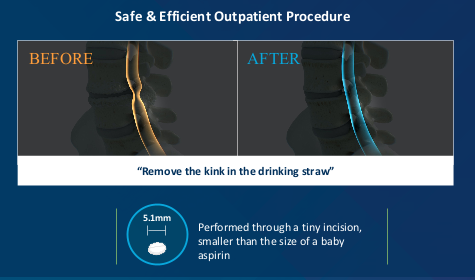Minimally Invasive Lumbar Decompression (MILD) Procedure -
What is the MILD Procedure?
The Minimally Invasive Lumbar Decompression (MILD) procedure is a safe, effective, and minimally invasive outpatient treatment for lumbar spinal stenosis (LSS). LSS is a condition where the spinal canal narrows, putting pressure on the spinal cord or nerves, leading to significant lower back pain and limited mobility.
The goal of the MILD procedure is to create more space for the nerves within the spinal canal, thus reducing the pressure and alleviating the pain caused by LSS. The procedure is called “minimally invasive” because it involves a tiny incision (usually less than 1 cm), causing less trauma to the surrounding tissue than traditional surgery.

What Can MILD Procedure Treat?
The primary indication for the MILD procedure is Lumbar Spinal Stenosis, a common condition often associated with aging. Patients with LSS typically experience lower back pain, numbness, or tingling in the legs, and difficulty walking. They may also experience a heavy or dragging feeling in their legs. If these symptoms sound familiar, the MILD procedure could be a suitable treatment option.
How is the MILD Procedure Administered?
The MILD procedure is performed on an outpatient basis and typically takes less than an hour. The patient is given local anesthesia and light sedation, ensuring their comfort throughout the procedure.
Using a live X-ray for guidance, I insert a small, specialized device through the tiny incision in the back. This device is used to remove small portions of bone and excess ligament tissue, effectively decompressing the area and relieving pressure on the nerves.
One of the key benefits of the MILD procedure is the quick recovery time. Most patients are able to return home the same day and can return to normal activities within a few days to weeks, depending on their individual situation.
What are the Risks?
As with any medical procedure, the MILD procedure does come with some risks. However, these are minimal and less severe than those associated with more invasive surgeries. Potential complications can include infection, bleeding, dural tear, or nerve injury. I take every precaution to minimize these risks, but it’s important to discuss these and any concerns you may have during your consultation.
Are You a Candidate for the MILD Procedure?
As your trusted pain management specialist, my goal is to help you live a life free from debilitating pain. If you or someone you may know has been struggling with persistent lower back pain and symptoms of Lumbar Spinal Stenosis, the MILD procedure may be an excellent solution. Contact our office to set up an appointment with Dr. Edward Rubin and his team.
You can set up an appointment by calling our office number or filling out the form on our Contact Us page
